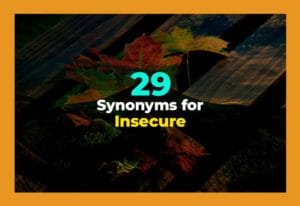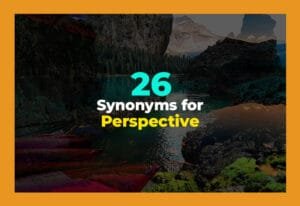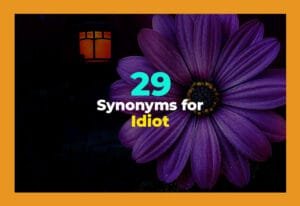When we talk about being part of a group, the word “among” often comes to mind. However, there are many other words you can use instead of “among,” like “amid,” “between,” or “within.” In this article, we will explore 26 synonyms for “among” and show how to use them in daily conversations.
| Synonym | Meaning | Example |
|---|---|---|
| Amid | In the middle of or surrounded by | She felt calm amid the chaos of the city. |
| Amongst | In the company of or surrounded by | He found comfort amongst his friends during the trip. |
| Between | In the space separating two things | The house is located between the river and the hill. |
| Within | Inside the limits of | There is a secret within the old castle walls. |
| Surrounded by | Having people or things all around | The village was surrounded by tall mountains. |
| In the midst of | In the middle of | She stood in the midst of the busy market. |
| Interspersed with | Placed at intervals among | The garden was interspersed with colorful flowers. |
| Throughout | In every part of | Happiness spread throughout the room during the celebration. |
| Amidst | In the middle of | He remained calm amidst all the confusion. |
| Among friends | Together with friends | She felt safe among friends at the party. |
| In company with | Being together with someone | He spent the day in company with his colleagues. |
| In the crowd | Surrounded by a group of people | She disappeared in the crowd at the festival. |
| Mixed with | Combined with | The soup was mixed with vegetables and spices. |
| Encircled by | Surrounded completely | The castle was encircled by a high wall. |
| Included in | Being part of a group | He was included in the list of winners. |
| In association with | Linked or connected with | The project was done in association with local schools. |
| Amidst all | In the middle of everything | Amidst all the noise, she could still think clearly. |
| Among many | Being part of a large number | He was chosen among many candidates. |
| In the company of | Together with | She enjoyed being in the company of her teachers. |
| Intermingled with | Mixed together | The colors were intermingled with each other on the canvas. |
| In the circle of | Within a group | He was welcomed in the circle of artists. |
| Among others | With other people | She was recognized among others for her talent. |
| Surrounded with | Completely enclosed by | The park was surrounded with tall trees. |
| Together with | In combination with | He worked together with his team to finish the project. |
| Amid all | In the middle of everything | Amid all the challenges, they stayed hopeful. |
Amid
“Amid” is used when something is in the middle of other things or situations. You can use it when talking about people, objects, or events around someone or something. It is very useful when describing feelings or actions happening in the middle of something else. For example, someone can feel calm amid trouble, or a small shop can stand amid a busy street.
- She stayed calm amid the loud crowd.
- The tree grew tall amid the rocks.
- He smiled amid the tension in the room.
Amongst
“Amongst” is another way to say “among,” and it often refers to being in the company of people or things. It gives the same meaning as “among” but can sometimes sound a bit formal or old-fashioned. Use it when talking about groups or communities, like friends, family, or collections of objects.
- She felt happy amongst her family.
- The book was hidden amongst other books.
- He walked quietly amongst the students.
Between
“Between” is used when talking about two people, things, or groups. It shows the position of someone or something in the middle. Even though “among” usually refers to more than two, “between” can sometimes be used in similar situations. Use “between” to show separation or a connection clearly.
- The ball rolled between the chairs.
- He shared the chocolate between his two friends.
- The conversation happened between the teacher and the student.
Within
“Within” means inside the limits of something. It can be used for space, time, or groups. It often shows something is part of an area or a situation. It is helpful when talking about feelings, rules, or physical places.
- The secret stayed within the family.
- She completed the task within an hour.
- The animals lived within the forest safely.
Surrounded by
“Surrounded by” describes something that has other things all around it. It shows that the person or object is in the middle of other objects, people, or natural things. It is a visual way to explain position or location.
- The house was surrounded by flowers.
- He felt safe surrounded by friends.
- The city was surrounded by rivers.
In the midst of
“In the midst of” is used to show being in the middle of a situation or activity. It often talks about events, actions, or feelings happening while other things are going on. This phrase gives a clear picture of being part of a larger scene or moment.
- She stood in the midst of the busy street.
- He stayed calm in the midst of confusion.
- The children played in the midst of the park.
Interspersed with
“Interspersed with” means that something is placed at intervals among other things. It can be used for objects, colors, or events. It helps describe how things are spread out in a group or area, making it more visual and descriptive.
- The garden was interspersed with flowers.
- Pages in the book were interspersed with pictures.
- His speech was interspersed with jokes.
Throughout
“Throughout” is used to show something happening in every part of a place, time, or situation. It is useful when talking about feelings, actions, or events that cover a large area or period. It makes the description wide and complete.
- Laughter spread throughout the room.
- The story traveled throughout the village.
- Happiness was seen throughout the festival.
Amidst
“Amidst” is similar to “amid” and means being in the middle of something. It is often used with situations, events, or groups. It can describe physical position or emotional state during an event or action.
- He stayed calm amidst the chaos.
- Flowers bloomed amidst the green grass.
- She found hope amidst sadness.
Among friends
“Among friends” shows being together with people you know well. It focuses on the feeling of safety, comfort, or fun when being in a group of friends. It can describe activities, emotions, or moments shared with friends.
- She laughed among friends.
- He felt safe among friends.
- They played games among friends.
In company with
“In company with” means being together with someone, usually for a purpose or activity. It can describe social situations, work, or travel. It shows partnership or presence in a polite way.
- He spent the day in company with his teachers.
- She went to the market in company with her friend.
- The artist painted in company with others.
In the crowd
“In the crowd” shows being part of a large group of people. It can describe situations like festivals, markets, or busy streets. It gives the idea of being surrounded but not alone.
- She disappeared in the crowd.
- He shouted in the crowd.
- Children played happily in the crowd.
Mixed with
“Mixed with” shows two or more things combined together. It can describe food, colors, materials, or even feelings. It helps explain how different parts come together in one place.
- The salad was mixed with vegetables.
- The colors were mixed with white.
- His happiness was mixed with excitement.
Encircled by
“Encircled by” describes being surrounded completely by something. It can be used for walls, trees, or groups. It gives the idea of safety, protection, or clear limits.
- The castle was encircled by a moat.
- The child felt safe encircled by family.
- The island was encircled by water.
Included in
“Included in” shows being a part of a group, list, or set. It often talks about selection, membership, or participation. It shows connection or belonging.
- He was included in the winners.
- She was included in the team.
- The book was included in the collection.
In association with
“In association with” shows being connected or linked with something or someone. It is useful for projects, events, or collaborations. It highlights partnership or cooperation.
- The event was in association with the school.
- He worked in association with a team.
- The project was done in association with local artists.
Amidst all
“Amidst all” emphasizes being in the middle of everything happening. It is useful to show focus, feelings, or actions while surrounded by events or challenges.
- Amidst all the noise, she stayed calm.
- He smiled amidst all difficulties.
- Flowers bloomed amidst all chaos.
Among many
“Among many” shows being part of a large number of things or people. It often highlights selection, uniqueness, or comparison.
- He was chosen among many students.
- She stood out among many competitors.
- The tree was tallest among many others.
In the company of
“In the company of” shows being together with someone, usually people you know or admire. It can describe feelings, experiences, or situations shared with others.
- She enjoyed being in the company of friends.
- He learned a lot in the company of teachers.
- They laughed in the company of family.
Intermingled with
“Intermingled with” shows two or more things mixed together. It is often used for colors, people, or events. It highlights blending or combining naturally.
- Colors were intermingled with light and dark shades.
- The crowd was intermingled with tourists and locals.
- His voice was intermingled with laughter.
In the circle of
“In the circle of” shows being part of a group with shared interests or activities. It can describe communities, friends, or professionals.
- He was welcomed in the circle of artists.
- She joined in the circle of writers.
- They worked together in the circle of engineers.
Among others
“Among others” means being part of a group or with other people. It often highlights a person or thing compared to others in the same group.
- She was recognized among others for her talent.
- The painting stood out among others.
- He was noticed among others in the crowd.
Surrounded with
“Surrounded with” shows being completely enclosed or covered by things. It can describe protection, beauty, or position.
- The garden was surrounded with trees.
- The room was surrounded with lights.
- He felt safe surrounded with friends.
Together with
“Together with” shows being in combination or cooperation with someone or something. It is useful for teamwork, friendship, or actions done jointly.
- He worked together with his team.
- She traveled together with her friend.
- They built the house together with neighbors.
Amid all
“Amid all” is used to emphasize being in the middle of many events, people, or situations. It shows focus or calmness in the middle of action.
- Amid all challenges, they stayed hopeful.
- She sang amid all noise.
- He laughed amid all troubles.

Final Thoughts
Using different words instead of “among” can make your sentences more interesting and clear. Each synonym has its own special meaning. Practice these words in daily life, and you will feel more confident in expressing yourself.









